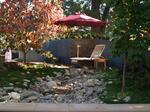Shaded Gardens
Every garden needs some shaded areas. Shade is both physically and psychologically cool and refreshing, particularly on a hot day. When we have shade in a garden, it is often seen as a negative – plants are harder to grow, lawn and drainage problems arise, and the garden can be less appealing for outdoor use. Funny thing though: when we don’t have it, we plant trees to get more shade, or we erect shade wings, gazebos or pergolas for shade.

What is different about a shaded garden?
- There is less light for plants
- Temperature variations are not as extreme as in the sunshine
- Ventilation may be reduced
- Moisture does not evaporate as quickly
- People are better protected from UV light
- There may be more chance of slipping/tripping on moist ground
Slime/moss can form on steps and paths
- In heavy shade, visibility is reduced, particularly where you enter shade and your eyes have not acclimatised
Plants for Shady Places
The following plants are ideal for growing in a shady garden:
Growing Plants in Dry Shade
Not all shade is moist. The ground surface under tree canopies, beneath eaves or between narrow walkways can be shaded but receive very little rain. If you have a problem growing plants in dry shade, try these options:
- choose suitable species, eg. Clivia
- provide extra water, preferably using a drip irrigation system
- use paving or mulch under heavy tree canopies instead of grass
Trees to Create Shade
In temperate climates, you can’t beat deciduous trees. They provide shade from summer sun, then lose their leaves and let the light in over winter.
In tropical climates, there aren’t so many deciduous trees, but the light is so much stronger in winter; so it doesn’t matter to have leaf cover all year round.
Creating Shady Nooks
A shaded nook is a very appealing place to retreat on a hot day. If you live in a hot climate, an area of dense shade is a great place for cooling off. In temperate areas, deciduous trees that filter the sun in summer and let the sun through the branches in winter make an enticing retreat.
How to create a shady nook with plants:
- Plant a tree with a spreading canopy. It doesn’t have to be a tall tree but the canopy must be broad enough to shade an area for sitting under in the hottest part of the day.
- Plant a clump of trees, preferably using the same species. You don’t need a large country garden to grow a clump of shady trees. For a small garden, use Silver Birches (Betula pendula), Crabapples (Malus ioensis) or Japanese Maples (Acer japonica) to give a dappled woodland effect. In tropical areas, plant palms in groves for year-round shade.
- Plant a clump or screen of dense shrubs – these are good for privacy as well as shade.
Creating a Fernery
Ferns can be grown outdoors in almost any moist, shady spot that is protected from wind and hot sun. If you don’t have a suitable area, you can create a fernery simply by building a structure covered in shade cloth or wooden slats to block out the sun.
For a large fernery, include tree ferns to provide a canopy for lower growing ferns. In a small fernery, include benches to display ferns and other shade-loving plants in pots at eye level. Ferns can also be grown in hanging pots suspended from the beams overhead.
Entertaining In a Shade Garden
A shade garden provides a ready-made place for entertaining or relaxing. All you need to do is add a few chairs and maybe a table.
More from ACS
Ebook - Shade types, creating shade, designs, shade plants, water, culture, propagation.
View eBook
Get a great overview of plant taxonomy, and learn to identify over 100 plants as well as many plant families.
View Course
Enhance your design skills and apply them to various garden styles.
View Course
Ebook - a great informative text to extend your knowledge and get it right the first time!
View eBook